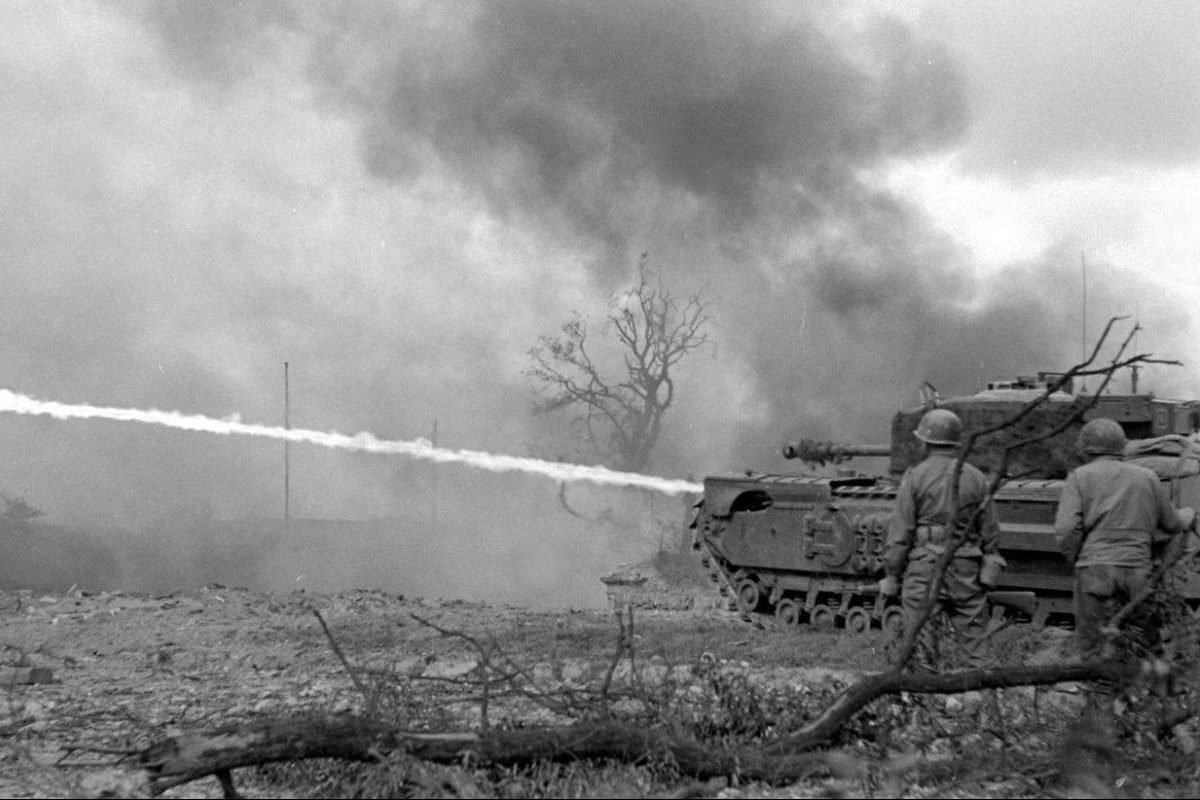WATCH: This World War II Churchill Crocodile Tank Spit Liquid Fire

Churchill Crocodile in action near Fort Montbarey. Brest, France, Sep 1944. Photo courtesy of (https://www.how-amps.org/churchill-crocodile).
Hobart’s Funnies were a series of American M4 Sherman tanks and British Mk IV tanks from Gen. Percy Hobart’s 79th Armoured Division. These specialist armored fighting vehicles derived from the standard tanks were tailored to meet specific mission demands of World War II. They were odd but efficient and necessary to get the job done.
The “Swimming” Sherman was an amphibious tank used on all five beaches during the invasion of Normandy on D-Day, and the “Crab” Flail Sherman had equipment mounted to the front to clear land mines. The Churchill AVRE (Armoured Vehicle Royal Engineer) tank was equipped with the Spigot mortar to destroy concrete bunkers and steel structures, while the Armoured Ramp Carrier, or ARK, Churchill tank had a foldable ramp in place of its turret to create a bridge that vehicles could cross.
The most feared of them all was the Churchill Crocodile — a tank that included a flamethrower capability. The Churchill Crocodile had a crew of five and towed a large storage chamber filled with more than 400 gallons of petroleum jelly. A common tactic used during the war was firing its main turret at a concrete bunker or building, then using the projector on the front to spit fire to reach the enemy occupants inside. The effective range was more than 100 yards, and the liquid fire stuck to everything it touched.
The Churchill Crocodile was among the most psychologically intimidating weapon systems of the war. Its napalm-like flamethrower, coupled with the armament and protection of a tank, was a living nightmare for German infantry. Since flamethrowers were viewed as an unpleasant and inhumane way to kill on the battlefield, the mere presence of a Churchill Crocodile made the enemy think twice. The flamethrower’s projector used a spark plug to ignite the flame. However, the Churchill Crocodile could spray unignited petroleum jelly in order to give enemy troops the option to surrender.

Matt Fratus is a history staff writer for Coffee or Die. He prides himself on uncovering the most fascinating tales of history by sharing them through any means of engaging storytelling. He writes for his micro-blog @LateNightHistory on Instagram, where he shares the story behind the image. He is also the host of the Late Night History podcast. When not writing about history, Matt enjoys volunteering for One More Wave and rooting for Boston sports teams.
BRCC and Bad Moon Print Press team up for an exclusive, limited-edition T-shirt design!
BRCC partners with Team Room Design for an exclusive T-shirt release!
Thirty Seconds Out has partnered with BRCC for an exclusive shirt design invoking the God of Winter.
Lucas O'Hara of Grizzly Forge has teamed up with BRCC for a badass, exclusive Shirt Club T-shirt design featuring his most popular knife and tiomahawk.
Coffee or Die sits down with one of the graphic designers behind Black Rifle Coffee's signature look and vibe.
Biden will award the Medal of Honor to a Vietnam War Army helicopter pilot who risked his life to save a reconnaissance team from almost certain death.
Ever wonder how much Jack Mandaville would f*ck sh*t up if he went back in time? The American Revolution didn't even see him coming.
A nearly 200-year-old West Point time capsule that at first appeared to yield little more than dust contains hidden treasure, the US Military Academy said.












